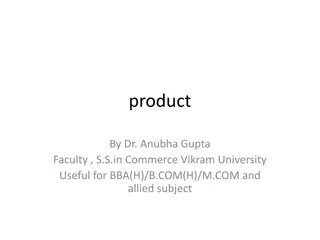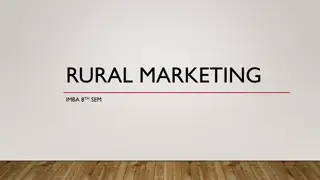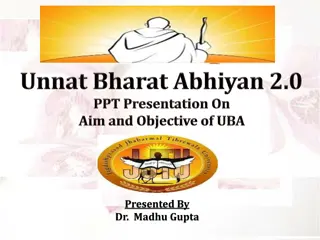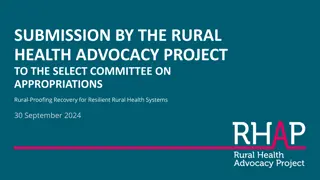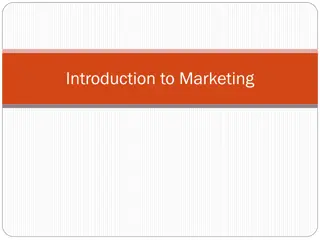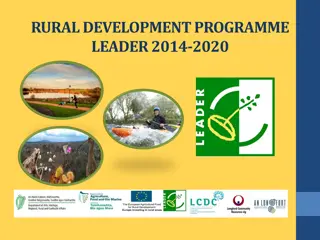Rural Marketing: Classification and New Product Development
In rural marketing, products are classified into FMCG, consumer durables, agricultural products, and services. Fast Moving Consumer Goods (FMCG) like toiletries and packaged food have a significant presence in rural areas. New product development involves aligning products with rural lifestyle and needs, with examples such as cooking gas cylinders and battery-operated devices. The process includes idea generation, concept development, and business strategy analysis to create successful products for rural markets.
Download Presentation

Please find below an Image/Link to download the presentation.
The content on the website is provided AS IS for your information and personal use only. It may not be sold, licensed, or shared on other websites without obtaining consent from the author.If you encounter any issues during the download, it is possible that the publisher has removed the file from their server.
You are allowed to download the files provided on this website for personal or commercial use, subject to the condition that they are used lawfully. All files are the property of their respective owners.
The content on the website is provided AS IS for your information and personal use only. It may not be sold, licensed, or shared on other websites without obtaining consent from the author.
E N D
Presentation Transcript
UNIT 3 Rural Marketing
CLASSIFICATION OF PRODUCTS FMCG Consumer Durables Agricultural Products Services
CLASSIFICATION OF PRODUCTS FMCG Fast Moving Consumer Goods (FMCG) goods are popularly named as consumer- packaged goods. Items in this category include all consumables people buy at regular intervals. The most common in the list are toilet soaps, detergents, shampoos, toothpaste, shaving products, shoe polish, packaged foodstuff, and household accessories. Major players are HUL, Dabur, Marico, Colgate Palmolive, Nirma, CavinKare and Godrej. As per the analysis by ASSOCHAM, Companies Hindustan Unilever Ltd, Dabur India originates half of their sales from rural India. While Colgate Palmolive India and Marico constitutes nearly 37% respectively. Nestle India Ltd and GSK Consumer drive 25 per cent of sales from rural India.
CLASSIFICATION OF PRODUCTS Agricultural Products Agricultural inputs such as seeds, fertilizers, pesticides, insecticides and implements (tractors, tillers and threshers) Livestock, poultry and fishery. Major players are Rallis India, Monsanto, DCM Shriram, Chambal Fertilisers, IFFCO, Mahindra & Mahindra, Eicher and Escorts. Services Telecommunications (BSNL), transport, health care, banking (SBI), insurance (LIC) and education.
NEW PRODUCT DEVELOPMENT One important aspect of designing products for rural markets is the product fit with the rural lifestyle and environment. Some new products introduced in rural markets are 5-kg cooking gas cylinder by HPCL; Jolly batter-operated color TV, Philips Free Power Radio, Kisan Credit Card etc. The Process involves Idea Generation The first stage of the New Product Development is the idea generation. In rural homes, the detergent bar used for washing clothes is cut into two pieces before use to ensure that it lasts longer due to less melting. But no marketer has addressed this need so far. Similarly areas with a problem of hard water would appreciate detergents able to cope with this factor. Idea Screening This second step of new product development involves finding those good and feasible ideas and discarding those which aren t. Concept Development and Testing A concept is a detailed strategy or blueprint version of the idea. Concept Testing in rural market needs to be done in different regions, as needs change from area to area depending upon the characteristics of a particular region. A concept of low-cost dry toilet promoted by UNICEF (requiring less water) was appreciated in water-scarce regions of Rajasthan, but was opposed in other regions where water availability is not a problem
NEW PRODUCT DEVELOPMENT (Cont.) Business Strategy Analysis and Development The testing results help the business in coming up with the final concept to be developed into a product. Estimated product profitability, marketing mix, and other product strategies are decided for the product. Product Development Once all the strategies are approved, the product concept is transformed into an actual tangible product. This development stage of new product development results in building up of a prototype or a limited production model. Test Marketing Unlike concept testing, the prototype is introduced for research and feedback in the test marketing phase. This process is of utmost importance as it validates the whole concept and makes the company ready for the launch. This is the most important factor in deciding the success or failure of the product. It becomes critical in the rural context where failure rates are high. Eicher Tractors aborted its idea of generating electricity through its tractors with the use of a generator powered by tractor engine. This was because the company found that it could not take care of the farmer s agricultural power purposes and could only be used for domestic purposes. It found that farmers use 5-KW water pumps for irrigation which ran on 3-phase power supply. Hence the company s single-phase, 3KW generator was not suitable. Because of limited space on tractors a bigger one could not be fit either. So safest bet was to abort! Commercialization The marketing mix is now put to use. Markets are decided for the product to launch in.
Channel Management The major challenges faced by the marketer in rural areas relate to the difficulties in reaching the geographically spread out market. The traditional channels used by marketers of consumer goods to reach rural markets are the wholesalers and retailers because of the following challenges:- Difficulty in reaching all brands to interior rural markets with the traditional multi-channel system. The need for higher frequency of servicing the rural retailers to ensure availability of stocks and reduce loss in sales due to stock outs. Requirement of large number of intermediaries which increases cost of distribution. Non-availability of dealers. Poor viability of retail outlets due to low business volume. Poor banking facilities. Poor road connectivity.
Channel Management (Cont.) An economical approach to reaching the geographically dispersed rural markets is using multiple levels in the channel. Marketers have introduced innovations in distribution to serve the geographically spread out, low density and low volume rural market with varying degree of success. Example: As seen from the efforts of ICICI Bank to innovate in accessing the rural market, the emerging channels are varied and are categorized here into mobile units, discovering or developing new institutions for partnering, and the use of Information Communication Technology (ICT). Bharat Petroleum has introduced Rural Marketing Vehicles to reach rural consumers. This vehicle moves from village to village and fills cylinders on the spot for the rural customers.
Rural Distribution Marketing in rural areas is essentially a problem of distribution. The companies may consider the following strategies in order to reach the rural mass. The companies may consider the following strategies in order to reach the rural masses:- Reach and Visibility: In a rural setup, it is essential for the companies to ensure that they have a good relationship with the local retailers. This will ensure continuous reach and also give the added advantage of getting appropriate amount of shelf space. Example: Colgate became synonymous with toothpaste, Surf became synonymous with washing detergent, etc. Reaching up to Mandis/ Towns/ Semi-Urban Areas: Companies can attend to the rural masses by reaching the feeder towns and mandis. Target Large Villages: Nearly 70% population live in villages. As such, targeting such large villages can be beneficial for the companies. Understanding Peak Seasons: The purchasing trends of rural consumers align with the peak seasons in the area. The peak seasons vary across the nation depending on festivals, weddings, etc. The companies should be aware of such times and make sure that their product is available for purchase. Delivery vans: Delivery vans can help companies reach select rural areas and also meet the customers directly. These can also serve as promotional tool for the company. Collaboration: Companies can tie-up with the established rural market players by means of collaboration. Sales Women Network: Companies can also employ rural women as part of their salesforce, who can go door-to-door selling products whilst building personal relationships. This has worked for HUL who call this means Project Shakti . Company s Own Distribution Network: Some companies have found that the local retailers are not aggressive enough to push their products and have been pilot testing their own distribution network in rural areas to be able to reach rural masses directly. Haats: Several people visit such haats from nearby villages and lack of regional and national players invite fakes and counterfeits. Having presence in haats, the companies can reach more people at fairly less cost. Melas: Melas or fairs can also be targeted by companies to meet rural consumers which are held time to time specially during festivals. Example: HUL targeted the Kumbh Mela (pilgrimage mela in Allahabad) to market its Lifebuoy soap through a campaign. Jobbers: The mobile traders who visit several villages can also be targeted to sell a company s merchandise. They can serve as great influencers of products.
Examples of Distribution Strategies Adopted by Various Companies ITC e-choupal initiative, which is looking at raising its present reach of 9,000 villages to 1,00,000 villages, and some 1,500 kiosks to 20,000 kiosks over the next 10 years, uses a communication model based on local language platforms. Godrej Consumer Products, introduced three brands of Cinthol, Fair Glow and Godrej in 50 gm. packs, priced at Rs. 4-5, meant specifically for Madhya Pradesh and Bihar. The company uses radio to reach the local people in their language and push its soap brands into the interior areas. Britannia Industries launched Tiger Biscuits, which was a huge success, especially for the rural markets. LG s Samporna , its customized TV for the rural market launched in 1998, was a huge success, selling 1,00,000 sets in the very first year. The company uses local language advertising and also uses vans and road shows to reach rural customers. HLL has built a strong distribution system, and has developed a direct access to markets through wholesale channel, creating awareness through media, demonstration and on ground contact. The company relies heavily on its own company-organized media by way of promotional events organized by stockists. HLL stockists use autorickshaws, bullock-carts, and even boats in the backwaters of Kerala, in order to service the remote villages. Coca Cola has evolved a hub and spoke distribution model to reach the villages. To ensure full loads, the company depot supplies large distributors who act as hubs twice a week, who in turn appoint and supply smaller distributors once a week. Because of the lack of electricity and refrigerators in the rural areas, Coca-Kola provides low-cost ice boxes a tin box for new outlets, and thermocol box for seasonal outlets. Coca-Cola uses a combination of TV, cinema and radio to reach 53.6% of rural households. It doubled the spend on Doordarshan, used banners and posters, and also tapped local forms of entertainment like annual haats and fairs, and made huge investments in infrastructure for distribution and marketing.
Integrated Marketing Communication in Rural Marketing Rural consumer behaviour differs from the urban consumer behaviour and so requires developing communication strategies unique to the rural markets. Sellers need to communicate to their target rural markets to inform them about the products they sell and to influence their behaviour for the products.
Challenges in Rural Communication Managing Spread and Diversity Understanding the Rural Audience Low Literacy Levels Limited Media Reach Poor Infrastructure Facilities Selective Attention to/Retention Linguistic and Socio-cultural differences
Effective Messages A major challenge for rural communicator is how to make the communicated messages effective. Languages: The message has to be understood. This requires communicating in a language that is meaningful to the consumer. Pictorial Presentation: The use of visuals as part of the message is important in rural markets as literacy levels are low. Source of the Message: Credibility of the source is critical for rural markets. Context Association: Associations create interest, hold attention and provide meaning.
Media Used Mass Media (Conventional) Television Radio Print Media Cinema Word of Mouth Video/On Wheels Traditional Media (Non-conventional) Wall Paintings Direct Mail Folk Theatre Banners placed on animals like elephants, camels etc. Puppetry Processions, tableau etc. Contests Mobile Vans Stalls, hoardings at local fairs
Different Promotional Strategies Advertising Personal Selling Sales Promotion Public Relations
Advertising Rural marketers would do well to understand the rural culture of how they use their time to create advertising campaigns most suited to them. The advertising differences need to cover the following areas: Print advertising to restrict itself to local press, pamphlets, hoardings like wall paintings, audio-visual vans, local cinema, outdoor media like camels, elephants, balloons and product displays, and merchandising. Language used should be easily understood by the local population. Timing should be just before the festive and harvest seasons. The art should be simple, easily understood by the rural masses
Ways of Advertising in Rural India In planning a promotional strategy, the variations in customs, habits, religion, attitudes and their interplay should not be overlooked. In the advertisements which are aimed at rural buyers, the advertiser should not make too many claims for his product, because they will not be remembered by the farmer, nor would he believe in them. It is better to release advertisements in the vernacular. The most discreet use of media at the minimum cost per contact should be made with minimum wastage in preference to the massive campaigns in all mass media.
Sales force Management in Rural Marketing The task of sales force management carries certain added dimensions in the rural context. In selecting the salesman, in giving the orientation, in motivating them and in developing them the sales manager has to adapt to the unique requirement of rural selling. The primary activities of sales force management in the rural context consist of having a sales organization geared to serve villages, accompanied by the HR functions of recruitment, compensation, training, supervision, evaluation and career growth. For companies that serve rural markets from their existing urban channels, the sales organization stops at the level of the city wholesaler and sometimes at the retailer in a town.
Rural marketing calls for some specific traits on the part of salesman. Willingness to be located in the rural areas. Cultural compatibility. Attitude factors. Knowledge of the local language. Ability to handle several product lines. Creativity. Travel.
Pricing Strategy in Rural Marketing Pricing strategies are linked to product strategies. The product packaging and presentation also keeps the price low to suit the rural consumer. Low Cost/Cheap Products: This is a common strategy widely adopted by manufacturing and marketing concerns wherein the price can be kept low by low unit packing like paisa pack of tea, shampoo sachets, etc. Refill Packs/Reusable Packaging: The containers can be put to multipurpose uses, which can have a significant impact in the rural market. E.g. tea, coffee & many other consumer goods re available in refill or reusable packages. Application of Value Engineering: In the food industry, Soya protein is being used instead of milk protein. The nutrition content of both being the same, Milk protein is expensive whereas Soya protein is cheaper. The basic aim being to reduce the value of the product so it becomes affordable to a larger segment, thus expanding its market.
Pricing Strategy in Rural Markets Inclusion of costs of warranties, guarantees, delivery and installation costs in pricing decisions. Buyers expectations. Budgetary constraints. Discounts. Credit Period. Logistics and delivery cost. Availability of government subsidiaries. Demand and supply scenario of the product market.
Examples Videocon was one of the first companies to enter the rural market with a plethora of products in the home appliances category. It attacked market leader Philips by launching a radio set for Rs.180 (Philips radio costs Rs.250) and grabbed a major chunk of the market. It continued with a similar strategy for its black & white TV, Washer washing machine and Walky range of cassette players. Samsung and LG promote their products during harvest season which also coincides with the marriage season. CavinKare realised that for a family of 5 members at Rs.2 per sachet and a minimum of 4 hair washes/per person/ per month would mean a Rs.40 spend for shampoo alone. This the company knew was much beyond the reach of an average rural family. Thus it re-worked its marketing formula and came out with a product that was priced at 0.50 paise. Today 65% of the company s sales comes from rural markets. When the whole toothpaste market faced a slump and de-growth in 2001, Anchor switches was one company that braved the heat and brought out it s Anchor vegetarian toothpaste. Priced much cheaper than the rest of the lot, the company quickly seized 4% of the market. That rural areas are still in need of basics like electricity, water and roads is a known fact. Honda realized that though a generator was a product that shopkeepers would love to have, even the cheapest priced genset was Rs. 20,000, which was much beyond their reach. So Honda came with a novel scheme of self- management where every month the shopkeepers would put Rs.1000 into a lottery. The person who won the lottery would be gifted the Honda genset. The scheme was repeated every month till every shopkeeper who participated received a genset. Thus Honda got its profit and the shopkeepers were happy!
Types Mahindra sells its tractors for a lower price but charge higher prices for servicing and spare parts. Consumer durable giants like LG, Samsung, Onida and Videocon are using this pricing strategy to penetrate into villages and small towns. (Optional Product Pricing). BSNL offered free telephone connections to rural consumers. ITC also kept no charges for its net facilities but charged for other transactions when using its e-Choupal (Captive Product Pricing). Arvind Mills revolutionized the concept of Jeans pants. Studying the rural market it found that an average pair of jeans priced at Rs. 300 was much above the reach of the rural consumer. There was also skepticism in wearing ready-made fit clothing. Thus Aravind brought out its Ruf n Tuf kit at Rs. 195 which was ready to stitch with zipper and buttons. The product was taken deep into villages and tailors were even trained. The strategy worked and within first 2 months, the demand crossed 10 lakh pieces. (Penetration Pricing). Godrej soaps offered rose, sandalwood and neem ingredients at economic prices (Economy Pricing). In order to avoid problems of change HLL sells Pepsodent, Pond s Dreamflower Talc, Pond s cold cream, Rin, Taaza, Fair & Lovely, Clinic Plus and Lux at Rs.5. (Coinage Pricing). Pricing Bata at Rs.199.95 can have tremendous results, although the consumer knows he is paying Rs. 200. Consumers on the other hand also tend to equate quality with pricing and so consider LG a better buy than most other TVs since it is costlier (Psychological Pricing).




